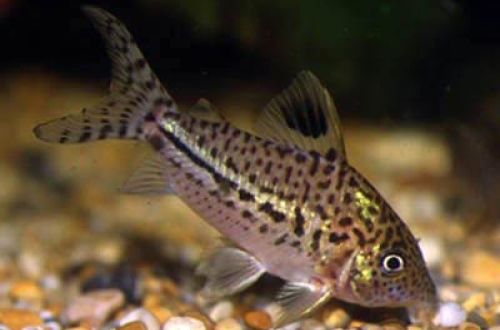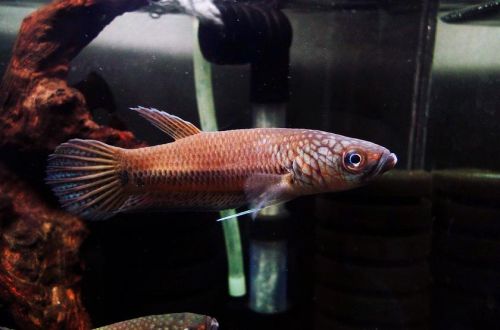
Cardinal
Cardinal, scientific name Tanichthys albonubes, belongs to the Cyprinidae family. The most popular aquarium fish, easy to keep and breed. As of 2010, there are four well-established breeding color forms, but only two of them are most widely used – close to natural color and with a predominance of red.
Hevitra ato Anatiny
Habitat
The homeland of the species is the territory of modern China. Currently, fish are practically not found in the wild and are on the verge of extinction, listed in the Red Book. Several relict populations have been found in the coastal province of Guangdong (southern China) and in the province of Quang Ninh, northeast Vietnam. They live in slow-flowing rivers and streams, prefer to stay at shallow depths up to 60 cm near dense coastal aquatic vegetation.
Fampahafantarana fohy:
- Ny habetsahan'ny aquarium - avy amin'ny 60 litatra.
- Ny mari-pana – 14-22°C
- Sanda pH - 6.0-8.5
- Water hardness – soft to hard (5-21dGH)
- Karazana substrate - na inona na inona
- Jiro - manetry tena
- Rano masirasira - tsia
- Fihetseham-pon'ny rano - tondra-drano malemy na rano tsy miova
- Ny haben'ny trondro dia mahatratra 4 sm.
- Sakafo - sakafo rehetra
- Temperament - trondro tony milamina
- Mijanona ao anaty andian'ondry misy olona 10
Description
Adults reach a length of 4 cm. Females are somewhat larger than males, but less colorful. There are several color forms. One is closer to natural coloration, the dominant color is gray with a wide bright pink stripe stretching from head to tail. The wide fins have a pale yellow edging. Another form has a similar color, but with a pronounced red pigment, which is painted on the back of the body, tail and edges of the fins.
sakafo
They accept all types of dry, frozen and live food. A combination of different species is the most preferred option, in this case the fish show their best color. Feed 2-3 times a day in the amount eaten in 5 minutes, remove leftovers in a timely manner to prevent water pollution.
Fikojakojana sy fikarakarana, fandaminana ny aquarium
The recommended volume of the tank for one flock of fish starts from 60 liters. The design is arbitrary, however, a combination of a dark substrate and a certain amount of floating plants is considered the best option. Artificial or natural snags, roots and / or branches of trees are used as decor.
The standard set of equipment consists of filtration and lighting systems, an aerator. The cardinal prefers relatively low temperatures, so there is no need for a heater if the aquarium is set up in a living area.
Water conditions are characterized by a weak internal flow, temperature, pH and dGH parameters are in a wide acceptable range of values, so the preparation of water is not associated with great difficulties, in most cases it is enough to defend it during the day.
Ny fikojakojana ny aquarium dia ny fanoloana ny ampahany amin'ny rano isan-kerinandro (20-25% amin'ny habetsahana) amin'ny rano madio, ny fanadiovana tsy tapaka ny substrate amin'ny fako organika ary ny fanesorana ny takelaka amin'ny vera.
Fitondran-tena sy fifanarahana
Calm peace-loving fish, goes well with other species of similar size and temperament, able to live in similar temperature conditions. The content is flocking from 10 individuals of both sexes; within the group, males are forced to compete with each other for the attention of females, which contributes to an increase in the brightness of their color.
Fiompiana / fiompiana
Cardinal refers to spawning species, females scatter eggs in the water column, and males at this moment fertilize it. Parental instincts are poorly developed, immediately after spawning, the fish can eat their own caviar and fry that have appeared.
Ny fiompiana dia asaina atao ao anaty fitoeran-drano mitokana - akquarium fanatobiana, mba hiarovana ny taranaka amin'ny trondro lehibe. Ny famolavolana dia tsotra, ny saina lehibe dia omena amin'ny tany, dia tokony ahitana sombin-javatra amin'ny habeny lehibe izay tsy mifanentana tsara, mamorona voids, ohatra, vatokely na vakana fitaratra haingon-trano. Rehefa milentika any ambany ny atody, dia latsaka ao anatin’ireny banga ireny ny ankamaroany ka lasa tsy azon’ny trondro. Misy vokany mitovy amin'izany koa ny fampiasana harato tsara, izay miorina eo ambany.
Ny fomba iray hafa hiantohana ny fitehirizana ny atody dia ny fampiasana zava-maniry na mosses kely misy raviny ambany toy ny Riccia mitsingevana sy Javanese moss, izay ambolena amin'ny ankamaroan'ny tany amin'ny substrate (amin'ity tranga ity dia mety misy ny tany). . Ny kirihitra matevina amin'ny zavamaniry dia afaka manome fialofana azo antoka ho an'ny atody tsy ratsy noho ny tany manokana.
Ny haben'ny Aquarium fanatodizana dia matetika 20-30 litatra, feno antsasany. Ny fitaovana ampiasaina dia aerator, fanafanana ary sivana sponjy tsotra amin'ny herin'ny kely mba hisorohana ny setroka tsy nahy ny atody sy ny endasina. Ao amin'ny hazavana manjavozavo no mitranga ny fanaterana, ka amin'ny voalohany dia tsy ilaina ny loharanon-jiro.
The impetus for the beginning of the mating season is the establishment of a water temperature in the region of the upper permissible mark of 20–21 ° C at a neutral or slightly acidic pH value, as well as the inclusion of protein foods in the daily diet – bloodworms, daphnia, brine shrimp in live or frozen form.
After some time, the females become noticeably rounder, and the males will begin to actively show signs of attention to their chosen ones. At this point, you should prepare a separate tank and fill it with water from the general aquarium, then transplant several females and the most colorful males there. The easiest way to determine the end of spawning is by females, they will become slender.
Averina ny trondro. Ny fry dia hiseho ao anatin'ny 48 - 60 ora, ary amin'ny andro hafa dia manomboka milomano malalaka izy ireo. Fahano amin'ny sakafo mikroskopika manokana ho an'ny trondro akquarium tanora.
Aretina trondro
Due to long-term hybridization and inbreeding, undesirable consequences appeared in the form of weak immunity and a high proportion of congenital malformations among juveniles. A balanced diet and suitable living conditions reduce the risk of disease, but do not eliminate them. Read more about symptoms and treatments in the Aquarium Fish Diseases section.





